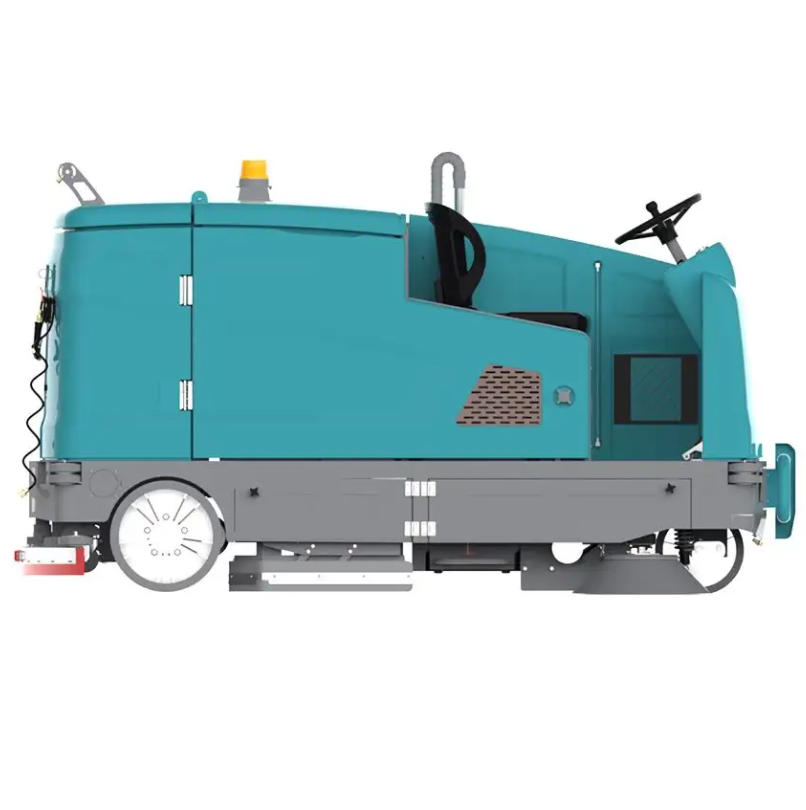Core Functions of Industrial Sweepers
Debris Collection Mechanisms
Industrial sweepers are equipped with advanced debris collection mechanisms, like rotary brushes, side brooms, and vacuum systems, to efficiently gather various debris types. These mechanisms play a crucial role by ensuring thorough cleaning from large items like leaves and rocks to finer particles such as dust. The design of these tools is intended for optimal efficacy, adapting to the size and type of debris encountered. With progressions in technology, these machines now integrate smart collection systems that adjust the collection mode based on the kind of debris detected. This level of adaptability ensures that sweepers maintain optimal performance across different cleaning environments, rendering them hugely effective in industrial settings.
Surface Adaptation Technology
Surface adaptation technology enables industrial sweepers to modify their cleaning techniques based on varying ground surfaces such as asphalt, concrete, and gravel. This technology utilizes sensors and adjustable brush heights to refine the sweeper’s operations in real-time, delivering maximum efficiency. For example, if the sweeper encounters a softer surface, it can alter its bristle softness or height to accommodate and effectively clean without causing damage. This adaptability is backed by research, highlighting its importance in maintaining cleanliness and safety across diverse environments, ensuring that industries can keep their spaces pristine regardless of the surface type.
Wet vs Dry Cleaning Capabilities
Industrial sweepers offer the versatility of both wet and dry cleaning capabilities, accommodating various types of debris and environmental needs. Wet cleaning is particularly effective when dealing with sticky residues or for locations prone to dust control issues, whereas dry cleaning handles loose debris such as leaves and dirt efficiently. The choice between these methods is heavily influenced by climate and location; in humid conditions, industries often prefer wet cleaning, whereas dry conditions lean towards dry methods. As per industry reports, each method’s effectiveness is marked by specific environmental scenarios, showcasing their roles in maintaining diverse working environments.
Key Components Powering Industrial Sweepers
Brush Systems and Rotational Dynamics
Brush systems, particularly cylindrical and disc brushes, play a crucial role in the sweeping efficiency of industrial sweepers. The type of brush system used often dictates the machine's ability to tackle various debris types effectively. Cylindrical brushes are generally adept at handling larger debris due to their design, whereas disc brushes excel at polishing and sweeping fine particles. Rotational speed and pressure are pivotal in determining the performance of these brush systems, allowing sweepers to adjust to different surfaces and cleaning requirements. For instance, a higher rotational speed may be necessary to remove adherent dirt, while gentle pressure ensures minimal surface abrasion. Specific brush designs optimize cleaning effectiveness in varied operational scenarios, enhancing overall debris management and extending the lifetime of the machinery.
Vacuum Suction and Airflow Engineering
The engineering behind vacuum suction and airflow in industrial sweepers is a masterful blend of science and technology aimed at boosting debris removal capabilities. Core principles such as suction power and airflow rates are tailored to improve operational efficiency, ensuring sweepers handle diverse debris types efficiently. Advanced airflow systems have been designed to maintain high performance while significantly reducing energy consumption, thus embodying the sustainability goals many industries strive to achieve. The ability to modulate suction power based on the sweep environment not only conserves energy but enhances the overall cleaning process, highlighting the innovation in today's industrial cleaning technology.
Hopper Design for Efficient Debris Management
The design of debris hoppers in industrial sweepers is integral to efficient storage and transportation during cleaning operations. Various designs, like tilting and dump hoppers, are pivotal to optimizing the unloading process while minimizing the user strain involved in debris disposal. Tilting hoppers allow easy discharge of collected debris, which is particularly useful in handling bulkier loads. On the other hand, dump hoppers facilitate a straightforward unloading mechanism, streamlining the disposal process and reducing operational downtime. Innovative hopper designs not only improve the overall debris management but also enhance the operational efficiency of industrial sweepers, ensuring they perform optimally across diverse industrial settings.
Advanced Filtration Systems in Modern Sweepers
Dust Containment Strategies
Modern sweepers utilize various dust containment strategies to enhance air quality during operation. Sealed systems and advanced filtration are crucial components that prevent airborne contaminants from escaping into the environment. For instance, many sweepers are equipped with multi-stage filtration systems that include pre-filters and high-efficiency filters to trap dust particles effectively. Case studies in industrial applications demonstrate that employing these strategies can significantly reduce dust emissions, thereby maintaining a healthier environment for workers and nearby communities.
HEPA Filtration for Hazardous Particles
In industrial sweepers, HEPA (High Efficiency Particulate Air) filtration systems play a vital role in capturing hazardous particles, ensuring compliance with stringent air quality regulations. HEPA filters are capable of capturing particles as small as 0.3 microns, which is essential for environments that handle toxic materials. According to the Environmental Protection Agency, HEPA filters can reduce exposure to hazardous dust significantly, thereby improving worker safety and overall air quality. Using these filters aligns with regulatory standards and helps industries maintain a safe working environment.
Automatic Filter Cleaning Technology
Automatic filter cleaning technology significantly enhances the operational efficiency of modern sweepers. These mechanisms reduce downtime and maintenance costs by enabling filters to be cleaned automatically during operation. This technology minimizes manual intervention, ensuring that sweepers can function continuously without performance dips. Industry reports suggest that integrating automatic filter cleaning systems reduces maintenance costs by up to 30%, providing both operational and economic benefits to industrial cleaning processes. By enhancing efficiency, this technology allows facilities to maintain optimal cleanliness standards without disrupting workflow.
Power Source Considerations (Electric/Diesel)
Selecting the correct power source for industrial sweepers is crucial, as it impacts performance, cost-efficiency, and environmental sustainability. Diesel sweepers offer robust power, ideal for heavy-duty tasks and outdoor settings. However, they can be noisy and contribute to greenhouse gas emissions. Conversely, electric sweepers are quieter and more environmentally friendly, aligning with the industry's push towards sustainable solutions. According to recent statistics, the market for electric sweepers is experiencing growth, driven by increased demand for eco-friendly cleaning solutions and stricter emission regulations, indicating a significant shift in industry preference.
Maneuverability and Coverage Efficiency
When it comes to maneuverability, ride-on and walk-behind sweepers cater to different needs. Ride-on sweepers excel in large open spaces like warehouses or parking lots, providing effecient coverage over vast areas. On the other hand, walk-behind sweepers shine in more compact spaces, such as offices or school corridors, where maneuverability is critical. Experts often recommend walk-behind models for facilities with numerous obstacles, while ride-on models are preferred for their speed and coverage in expansive settings. User surveys reveal a general preference for walk-behind sweepers in environments with limited space, highlighting their effectiveness in tight quarters.
Specialized Applications for Different Models
Industrial sweepers are designed to meet various cleaning needs, and selecting the right model is essential for maximizing efficiency. For instance, ride-on sweepers are often customized for outdoor use, equipped with robust tires and advanced dust control to handle larger debris and uneven surfaces. Meanwhile, walk-behind sweepers are often adapted for indoor cleaning tasks, boasting features like HEPA filters to capture fine dust and other particles. By selecting the optimal model, industries can achieve superior cleaning efficiency, supported by extensive data that showcases performance improvements when machine features align with operational needs.
Maintenance and Compliance Considerations
Maintenance
Routine maintenance is imperative for industrial sweepers to ensure their efficiency and longevity. By adhering to regular inspection schedules and maintenance practices, industries can significantly mitigate risks of breakdowns and costly repairs. Industry experts recommend regular checks and maintenance for crucial components such as brush systems, filters, and hydraulic systems, as they are the core elements responsible for ensuring optimal functionality. Adhering to maintenance schedules not only increases the operational lifespan of sweepers but also helps maintain high cleaning standards, necessary for compliance with industry regulations.
Meeting Environmental Regulations
Environmental compliance is a crucial aspect of operating industrial sweepers, especially in regions governed by strict regulations. Features like advanced filtering systems and pollution control technologies are essential for meeting these standards. Modern sweepers are equipped with smart technologies that adapt to specific environmental requirements, reducing emissions and the environmental footprint of cleaning operations. By aligning with environmental regulations, businesses can achieve cleaner environments and demonstrate their commitment to maintaining a responsible environmental impact, thus enhancing their reputation and ensuring long-term sustainability.
FAQ Section
What are the main types of industrial sweepers?
The main types of industrial sweepers include ride-on sweepers and walk-behind sweepers. Ride-on sweepers are suitable for large areas, while walk-behind sweepers are better for navigating smaller, obstacle-dense environments.
What is surface adaptation technology in industrial sweepers?
Surface adaptation technology in industrial sweepers enables the machines to adjust their cleaning techniques and capabilities based on the type of surface they encounter, from asphalt and concrete to gravel, ensuring efficient and safe cleaning.
How do industrial sweepers manage dust and small particles?
Modern industrial sweepers use advanced filtration systems like multi-stage filtration and HEPA filters to effectively contain dust and small particles, improving air quality and complying with environmental norms.
What are the differences between wet and dry cleaning in industrial sweepers?
Wet cleaning in industrial sweepers is ideal for removing sticky residues and controlling dust in humid environments, while dry cleaning is suited for picking up loose debris like leaves and dirt, especially in dry conditions.
Which is better, an electric or diesel-powered industrial sweeper?
The choice between electric and diesel-powered sweepers depends on the specific industrial needs. Diesel sweepers are powerful for heavy-duty, outdoor tasks, whereas electric sweepers are quieter and eco-friendly, suitable for indoor use.
Table of Contents
- Core Functions of Industrial Sweepers
- Key Components Powering Industrial Sweepers
- Advanced Filtration Systems in Modern Sweepers
- Power Source Considerations (Electric/Diesel)
- Maintenance and Compliance Considerations
-
FAQ Section
- What are the main types of industrial sweepers?
- What is surface adaptation technology in industrial sweepers?
- How do industrial sweepers manage dust and small particles?
- What are the differences between wet and dry cleaning in industrial sweepers?
- Which is better, an electric or diesel-powered industrial sweeper?
 EN
EN
 AR
AR
 FR
FR
 HI
HI
 JA
JA
 KO
KO
 PT
PT
 RU
RU
 ES
ES
 IW
IW
 VI
VI
 TH
TH
 MS
MS

